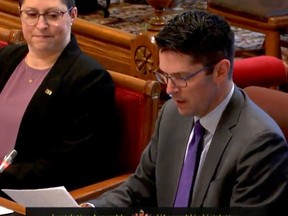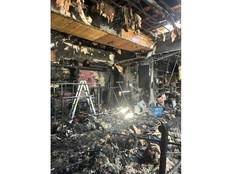Government reveals size of student population explosion
Province's net primary school student population rose by almost 10,000 between end of September 2020, January 2024

Article content
New Brunswick’s net primary school student population rose by almost 10,000 between the end of September 2020 and January this year.
The news was revealed during a legislative committee appearance by Ryan Donaghy, the deputy education minister for the anglophone sector, and his francophone counterpart, Julie Beaulieu Mason.
All four anglophone-sector school districts saw significant jumps, and so did Francophone School District South.
The biggest rise was in Anglophone School District East, which saw an extra 3,238 students arrive in that three-and-a-half year span. That’s a 20 per cent jump.
In Anglophone School District West, the largest in the province, a net rise of 2,006 more students was recorded, up nine per cent.
In Anglophone School District South, the student population has seen a net rise of 1,820 students in the last 3.5 years, an eight per cent jump.
In Anglophone School District North, the student population rose by 13 per cent, or 923 net more students.
In Francophone School District South, there was a net rise of 1,757 students. That’s up 11 per cent.
The two French districts in the north, however, were a different story.
In Francophone School District Northeast, the net number of students dropped by 19. And in Francophone School District Northeast, the net rise was just 16 students.
“We started seeing increases in 2018, in small numbers,” Donaghy said, adding that the net provincial rise was just 140 students.
In 2019, the jump was much bigger: 1,070.
But in 2020 there was a drop of 1,702 students “due to the pandemic, erasing those increases,” Donaghy said.
In 2021, the net student population rose 1,984. In 2022, that jumped to 3,687. That rise was slightly lower in 2023: a net gain of 3,547 students.
The government has previously said its projections show that the net primary school student population will rise again this year.
That explosion, however, has caused problems.
Premier Blaine Higgs referenced the double-edged sword of rapid population growth during his recent State of the Province address.
His numbers didn’t quite match the data presented on Thursday; it appears he undersold the size of the increase.
“We are in a period of tremendous growth,” Higgs said.
“And while it can be exciting to see so much development and interest in our province, it’s also been difficult managing that growth with the impact this is having on housing, health care, and schools.
“We are investing more than ever but the reality is that our growth has come very quickly, and we are introducing major shifts that take time.
“Just a few years ago we were closing schools, and now we’re seeing soaring enrollments of 6,000 new students since 2019, and we expect to see 6,000 more over the next five years.”
Child care
New data was also revealed about New Brunswick’s push to create more childcare spaces.
Since January last year, via the federal $10-a-day care program, 699 child care spots have been allocated for English-speaking facilities, but only 201 have been declared “open,” or available.
In French-speaking facilities, 275 spaces were allocated, and 151 are open.
There are 3,500 names on the waitlist for child care, including after-school programs. Twenty per cent of the names on that list are unborn children, and seven per cent are school-aged kids, the deputy ministers said.
The committee also asked questions about several other topics, including staffing levels, the education department’s pandemic preparedness, school districts’ travel expenses, and the bus system.
Like other departments, education hasn’t decided whether it will do its own post-pandemic performance review. Last year, Higgs said the government will do an “after-action” review that will examine every department.












Postmedia is committed to maintaining a lively but civil forum for discussion. Please keep comments relevant and respectful. Comments may take up to an hour to appear on the site. You will receive an email if there is a reply to your comment, an update to a thread you follow or if a user you follow comments. Visit our Community Guidelines for more information.